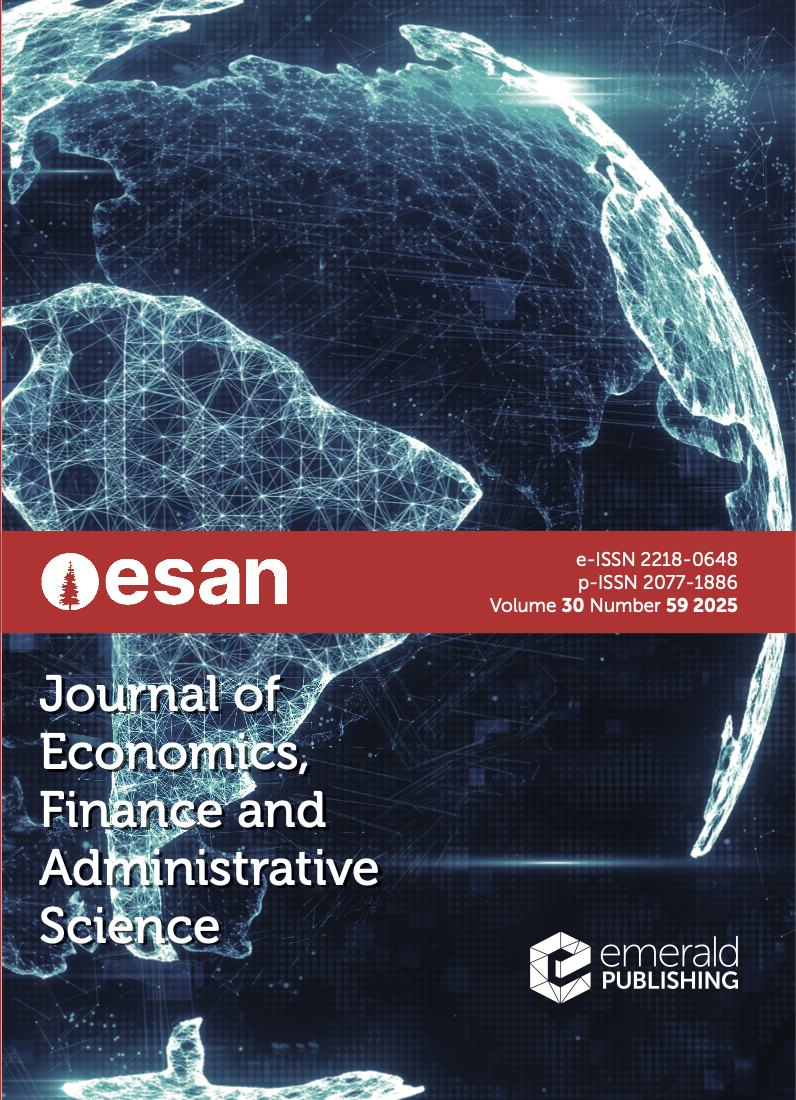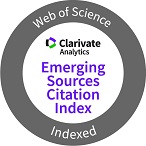Going long, going short, issue or liquidate? Corporate debt maturity of Mexican public firms
Keywords:
Debt maturity, Tobit, Mexican firms, McDonald and Moffitt decompositionAbstract
PurposeThis paper studies the determinants of the debt maturity of Mexican-listed companies by analysing the effects on the extensive (issuing or liquidating debt) and the intensive (debt maturity renegotiation) margins.
Design/methodology/approachThis study, using a Tobit model for panel data and measuring maturity as a time variable, shows that size, liquidity and leverage, among other firm characteristics, as well as the market interest rate, explain debt maturity. Additionally, the study employs the McDonald and Moffitt decomposition to determine whether the explanatory variables of maturity have a more significant effect on the decision to issue or liquidate debt or on debt maturity renegotiations.
FindingsThe results obtained highlight that the market interest rate negatively affects debt maturity. On the other hand, variables like size, liquidity, collateral and leverage demonstrate a positive relationship with the dependent variable. In addition, the extensive margin has a higher impact on corporate debt than the intensive margin, suggesting that firms prefer to liquidate or issue new debt rather than renegotiate preexisting contracts.
Research limitations/implicationsThe main limitation of this study is the use of an unbalanced panel. The lack of data limits the application of specific methodologies suggested by the literature as a way to test the robustness of the estimates.
Originality/valueFirst of all, this study adds empirical evidence of debt maturity decisions by publicly traded firms in a middle-income country such as Mexico to the existing literature on maturity choice. Second, the study treats debt maturity as a time-censored, limited variable. Finally, the authors have used the McDonald and Moffitt (1980) methodology to decompose the effect of each independent variable into extensive and intensive margins.
Downloads
References
Allaya, M., Derouiche, I. and Muessig, A. (2022), “Voluntary disclosure, ownership structure, and corporate debt maturity: a study of French listed firms”, International Review of Financial Analysis, Vol. 81, 101300, doi: 10.1016/j.irfa.2018.12.008.
Antoniou, A., Guney, Y. and Paudyal, K. (2006), “The determinants of debt maturity structure: evidence from France, Germany, and the UK”, European Financial Management, Vol. 12 No. 2, pp. 161-194, doi: 10.1111/j.1354-7798.2006.00315.x.
Axelson, U., Jenkinson, T., Strömberg, P. and Weisbach, M. (2013), “Borrow cheap, buy high? The determinants of leverage and pricing in buyouts”, The Journal of Finance, Vol. 68 No. 6, pp. 2223-2267, doi: 10.1111/jofi.12082.
Barclay, M. and Smith, J., C. (1995), “The maturity structure of corporate debt”, The Journal of Finance, Vol. 50 No. 2, pp. 609-631, doi: 10.2307/2329421.
Basel Committee on Banking Supervision (2011), “Principles for the sound management of operational risk”, available at: https://www.bis.org/publ/bcbs195.htm (accessed 29 February 2023).
Billett, M., King, T.H. and Mauer, D. (2007), “Growth opportunities and the choice of leverage, debt maturity, and covenants”, The Journal of Finance, Vol. 62 No. 2, pp. 697-730, doi: 10.1111/j.1540-6261.2007.01221.x.
Brick, I.E. and Ravid, S.A. (1985), “On the relevance of debt maturity structure”, The Journal of Finance, Vol. 40 No. 5, pp. 1423-1437, doi: 10.1111/j.1540-6261.1985.tb02392.x.
Campbell, J.Y. (1995), “Some lessons from the yield curve”, The Journal of Economic Perspectives, Vol. 9 No. 3, pp. 129-152, doi: 10.1257/jep.9.3.129.
Campbell, J.Y. and Shiller, R.J. (1991), “Yield spread and interest rate movements: a bird's eye view”, The Review of Economic Studies, Vol. 58 No. 3, pp. 495-514, doi: 10.2307/2298008.
Caprio, G. and Demirgüç-Kunt, A. (1998), “The role of long-term finance: theory and evidence”, The World Bank Research Observer, Vol. 13 No. 2, pp. 171-189, available at: https://www.jstor.org/stable/3986337 (accessed 1 March 2023).
Casino, A., López, J., Mestre, R. and Peiró, A. (2019), “An agency approach to debt maturity of unlisted and listed firms in the European setting”, European Management Journal, Vol. 37 No. 3, pp. 339-352, doi: 10.1016/j.emj.2018.07.008.
Castañeda, F. and Contreras, F. (2017), “Los determinantes de la estructura de la madurez de la deuda corporativa. El caso de Chile”, El Trimestre Economico, Vol. 84 No. 334, pp. 411-425, doi: 10.20430/ete.v84i334.306.
Chen, H., Xu, Y. and Yang, J. (2021), “Systematic risk, debt maturity, and the term structure of credit spreads”, Journal of Financial Economics, Vol. 139 No. 3, pp. 770-799, doi: 10.1016/j.jfineco.2020.09.002.
Chenari, H., Darabi, R. and Chaharmahali, S. (2023), “The effect of bankruptcy risk on stock price crash risk by emphasis on debt maturity”, Iranian Journal of Accounting, Auditing, and Finance, doi: 10.22067/IJAAF.2023.81475.1305.
Choi, J., Hackbarth, D. and Zechner, J. (2018), “Corporate debt maturity profiles”, Journal of Financial Economics, Vol. 130 No. 3, pp. 484-502, doi: 10.1016/j.jfineco.2018.07.009.
Colla, P., Ippolito, F. and Li, K. (2013), “Debt specialization”, The Journal of Finance, Vol. 68 No. 5, pp. 2117-2141, doi: 10.1111/jofi.12052.
Custódio, C., Ferreira, M. and Laureano, L. (2013), “Why are US firms using more short-term debt?”, Journal of Financial Economics, Vol. 108 No. 1, pp. 182-212, Vil, doi: 10.1016/j.jfineco.2012.10.009.
Datta, S., Doan, T. and Iskandar-Datta, M. (2019), “Policy uncertainty and the maturity structure of corporate debt”, Journal of Financial Stability, Vol. 44, 100694, doi: 10.1016/j.jfs.2019.100694.
Datta, S., Doan, T. and Toscano, F. (2024), “Does firm culture influence corporate financing decisions? Evidence from debt maturity choice”, Journal of Banking & Finance, Vol. 169, 107310, doi: 10.1016/j.jbankfin.2024.107310.
Demirgüç-Kunt, A. and Maksimovic, V. (1999), “Institutions, financial markets, and firm debt maturity”, Journal of Financial Economics, Vol. 54 No. 3, pp. 295-336, doi: 10.1016/S0304-405X(99)00039-2.
Demirgüç-Kunt, A., Martinez, M.S. and Tressel, T. (2015), “The impact of the global financial crisis on firms' capital structure”, Working Paper No. 7522, World Bank Policy Research, World Bank, 20 April, available at: https://ssrn.com/abstract=2706884 (accessed 2 March 2023).
Diamond, D.W. (1991), “Debt maturity structure and liquidity risk”, Quarterly Journal of Economics, Vol. 106 No. 3, pp. 709-737, doi: 10.2307/2937924.
Diamond, D.W. (1993), “Seniority and maturity of debt contracts”, Journal of Financial Economics, Vol. 33 No. 3, pp. 341-368, doi: 10.1016/0304-405X(93)90011-Y.
Etudaiye-Muhtar, O.F., Ahmad, R. and Tunde, B. (2017), “Corporate debt maturity structure: the role of firm-level and institutional determinants in selected African countries”, Global Economic Review, Vol. 46 No. 4, pp. 422-440, doi: 10.1080/1226508X.2017.1350589.
Fan, J., Titman, Sh. and Twite, G. (2012), “An international comparison of capital structure and debt maturity choices”, Journal of Financial and Quantitative Analysis, Vol. 47 No. 1, pp. 23-56, doi: 10.1017/S0022109011000597.
Farfán, L., Moreno, J.O. and Adamuz, M.M. (2022), “Madurez de la deuda corporativa como variable de tiempo: evidencia de las empresas públicas de México”, Revista Mexicana de Economía y Finanzas Nueva Época REMEF, Vol. 17 No. 3, pp. 1-34, doi: 10.21919/remef.v17i3.688.
Farhangdoust, S., Salehi, M. and Molavi, H. (2020), “Management stock ownership and corporate debt: evidence from an emerging market”, Management Research Review, Vol. 43 No. 10, pp. 1221-1239, doi: 10.1108/MRR-12-2018-0475.
Faysal, S., Salehi, M. and Moradi, M. (2020a), “The impact of ownership structure on the cost of equity in emerging markets”, Management Research Review, Vol. 43 No. 10, pp. 1221-1239, doi: 10.1108/MRR-11-2019-0475.
Faysal, S., Salehi, M. and Moradi, M. (2020b), “Impact of corporate governance mechanisms on the cost of equity capital in emerging Markets”, Journal of Public Affairs, Vol. 21 No. 2, doi: 10.1002/pa.2166.
Flannery, M.J. (1986), “Asymmetric information and risky debt maturity choice”, The Journal of Finance, Vol. 41 No. 1, pp. 19-37, doi: 10.2307/2328342.
Flannery, M.J. (1994), “Debt maturity and the deadweight cost of leverage: optimally financing banking firms”, The American Economic Review, Vol. 84 No. 1, pp. 320-331, available at: https://www.jstor.org/stable/2117987 (accessed 2 March 2023).
Fu, X., Huang, M. and Tang, T. (2022), “Duration of executive compensation and maturity structure of corporate debt”, Journal of Corporate Finance, Vol. 73, 102188, doi: 10.1016/j.jcorpfin.2022.102188.
Giannetti, M. (2003), “Do better institutions mitigate agency problems? Evidence from corporate finance choices”, Journal of Financial and Quantitative Analysis, Vol. 38 No. 1, pp. 185-212, doi: 10.2307/4126769.
González, V.M. (2017), “Firm and country determinants of debt maturity: new international evidence”, International Finance, Vol. 20 No. 3, pp. 256-270, doi: 10.1111/infi.12116.
Greene, W.H. (2004), “Fixed effects and bias due to the incidental parameters problem in the Tobit model”, Econometric Reviews, Vol. 23 No. 2, pp. 125-147, doi: 10.1081/ETC-120039606.
Guedes, J. and Opler, T. (1996), “The determinants of the maturity of corporate debt issues”, The Journal of Finance, Vol. 51 No. 5, pp. 1809-1833, doi: 10.1111/j.1540-6261.1996.tb05227.x.
Hassan, M.K., Karim, Md. S. and Kozlowski, S.E. (2022), “Implications of public corruption for local firms: evidence from corporate debt maturity”, Journal of Financial Stability, Vol. 58, 100975, doi: 10.1016/j.jfs.2022.100975.
Kalsie, A. and Nagpal, A. (2018), “The determinants of corporate debt maturity for NSE-listed corporates”, FIIB Business Review, Vol. 7 No. 1, pp. 43-56, doi: 10.1177/2319714518766117.
Kane, A., Marcus, A.J. and McDonald, R.L. (1985), “Debt policy and the rate of return premium to leverage”, Journal of Financial and Quantitative Analysis, Vol. 20 No. 4, pp. 479-499, doi: 10.2307/2330763.
Kirch, G. and Terra, P.R. (2012), “Determinants of corporate debt maturity in South America: do institutional quality and financial development matter?”, Journal of Corporate Finance, Vol. 18 No. 4, pp. 980-993, doi: 10.1016/j.jcorpfin.2012.05.004.
Körner, P. (2007), “The determinants of corporate debt maturity structure: evidence from Czech firms”, Czech Journal of Economics and Finance, Vol. 57 No. 3, pp. 142-158, available at: https://www.researchgate.net/publication/5022002_The_determinants_of_corporate_debt_maturity_structure_Evidence_from_Czech_firms (accessed 28 February 2023).
Kuč, V. and Kaličanin, Đ. (2021), “Determinants of the capital structure of large companies: evidence from Serbia”, Economic Research - Ekonomska Istraživanja, Vol. 34 No. 1, pp. 590-607, doi: 10.1080/1331677X.2020.1801484.
Lemma, T.T., Azmi Shabestari, M., Freedman, M., Lulseged, A. and Mlilo, M. (2020), “Corporate carbon risk, voluntary disclosure, and debt maturity”, International Journal of Accounting and Information Management, Vol. 28 No. 4, pp. 667-683, doi: 10.1108/ijaim-06-2019-0064.
Mayer, C. (1990), “Asymmetric information, corporate finance, and economic development”, in Hubbard, R. (Ed.), Asymmetric Information, Corporate Finance, and Investment, University of Chicago Press, Chicago, IL, pp. 307-332, available at: http://www.nber.org/chapters/c11477 (accessed 27 February 2023).
McCown, J.R. (1999), “The effects of inverted yield curves on asset returns”, The Financial Review, Vol. 34 No. 2, pp. 109-126, doi: 10.1111/j.1540-6288.1999.tb00457.x.
McDonald, J.F. and Moffitt, R.A. (1980), “The uses of Tobit analysis”, The Review of Economics and Statistics, Vol. 62 No. 2, pp. 318-321, doi: 10.2307/1924766.
Morris, J.R. (1992), “Factors affecting the maturity structure of corporate debt”, unpublished manuscript, the University of Colorado at Denver, Denver, CO, p. 39.
Myers, S.C. (1977), “Determinants of corporate borrowing”, Journal of Financial Economics, Vol. 5 No. 2, pp. 147-175, doi: 10.1016/0304-405X(77)90015-0.
Orman, C. and Köksal, B. (2017), “Debt maturity across firm types: evidence from a major developing economy”, Emerging Markets Review, Vol. 30, pp. 169-199, doi: 10.1016/j.ememar.2016.12.001.
Parise, G. (2018), “Threat of entry and debt maturity: evidence from airlines”, Journal of Financial Economics, Vol. 127 No. 2, pp. 226-247, doi: 10.1016/j.jfineco.2017.11.009.
Phan, D.T. (2020), “Factors affecting debt maturity structure: evidence from listed enterprises in Vietnam”, Journal of Asian Finance, Economics, and Business, Vol. 7 No. 10, pp. 141-148, doi: 10.13106/jafeb.2020.vol7.no10.141.
Poeschl, J. (2023), “Corporate debt maturity and investment over the business cycle”, European Economic Review, Vol. 152, 104348, doi: 10.1016/j.euroecorev.2022.104348.
Quinn, M.D., Zhang, L. and Mi, L. (2022), “Yield curve inversions: a study of country-level and firm-level stock reactions”, International Review of Finance, Vol. 22 No. 1, pp. 278-285, doi: 10.1111/irfi.2345.
Rauh, J. and Sufi, A. (2010), “Capital structure and debt structure”, Review of Financial Studies, Vol. 23 No. 12, pp. 4242-4280, doi: 10.3386/w14488.
Salehi, M., Sadatifar, Z. and Adibian, M.S. (2021a), “The impact of the characteristics and behaviors of the board of directors on agency costs in Iran”, Contaduría Y Administración, Vol. 66 No. 1, p. 229, doi: 10.22201/fca.24488410e.2021.2384.
Salehi, M., Adibian, M.S., Sadatifar, Z. and Khansalar, E. (2021b), “The relationship between corporate governance characteristics and agency costs”, Zb. Rad. Ekon. ̀ Fak. au Rijec., Vol. 39 No. 1, pp. 199-220, doi: 10.18045/zbefri.2021.1.199.
Schmukler, S. and Vesperoni, E. (2006), “Financial globalization and debt maturity in emerging economies”, Journal of Developing Economics, Vol. 79 No. 1, pp. 183-207, doi: 10.1016/j.jdeveco.2004.12.006.
Smith, C.W., Jr and Warner, J.B. (1979), “On financial contracting: an analysis of bond covenants”, Journal of Financial Economics, Vol. 7 No. 2, pp. 117-161, doi: 10.1016/0304-405X(79)90011-4.
Stephan, A., Talavera, O. and Tsapin, A. (2011), “Corporate debt maturity in emerging financial markets”, The Quarterly Review of Economics and Finance, Vol. 51 No. 2, pp. 141-151, doi: 10.1016/j.qref.2010.12.003.
Stohs, M.H. and Mauer, D.C. (1996), “The determinants of corporate debt maturity”, Journal of Business, Vol. 69 No. 3, pp. 279-312, doi: 10.1086/209692.
Sur, J.K. and Chauhan, Y. (2021), “Group affiliation and corporate debt maturity: co-insurance or expropriation”, International Journal of Managerial Finance, Vol. 17 No. 5, pp. 687-707, doi: 10.1108/IJMF-04-2020-0197.
Terra, P.R. (2011), “Determinants of corporate debt maturity in Latin America”, European Business Review, Vol. 23 No. 1, pp. 45-70, doi: 10.1108/09555341111097982.
Titman, S. (1992), “Interest rate swaps and corporate financing choices”, The Journal of Finance, Vol. 47 No. 4, pp. 1503-1516, doi: 10.1111/j.1540-6261.1992.tb04667.x.
Toader, D.A., Vintila, G. and Gherghina, S.C. (2022), “Firm-and country-level drivers of capital structure: quantitative evidence from central and eastern European listed companies”, Journal of Financial Studies & Research, Vol. 2022, pp. 1-12, doi: 10.5171/2022.572694.
Tobin, J. (1958), “Estimation of relationships for limited dependent variables”, Econometrica, Vol. 26 No. 1, pp. 24-36, doi: 10.2307/1907382.
Villezca, P.A. and Moreno, J.O. (2000), “Análisis del consumo de cerveza en el área metropolitana de Monterrey: un modelo de respuesta censurada”, Estudios Económicos, Vol. 15 No. 02, pp. 249-280, available at: https://www.jstor.org/stable/40311434 (accessed 25 February 2023).
Wang, X.H. and Yang, B.Z. (2012), “Yield curve inversion and the incidence of recession: a dynamic IS-LM model with the term structure of interest rates”, Internacional Advances in Economic Research, Vol. 18 No. 2, pp. 177-185, doi: 10.1007/s11294-012-9350-7.
Zhang, T., Wang, Y. and Zeng, X. (2024), “Supplier concentration and debt maturity structure”, Business Process Management Journal, Vol. 30 No. 2, pp. 612-636, doi: 10.1108/BPMJ-06-2023-0475.
Zheng, X., El Ghoul, S., Guedhami, O. and Kwok, Ch.C. (2012), “National culture and corporate debt maturity”, Journal of Banking & Finance, Vol. 36 No. 2, pp. 468-488, doi: 10.1016/j.jbankfin.2011.08.004.
Zhou, M., Huang, Z. and Jiang, K. (2024), “Environmental, social, and governance performance and corporate debt maturity in China”, International Review of Financial Analysis, Vol. 95, 103349, doi: 10.1016/j.irfa.2024.103349.











